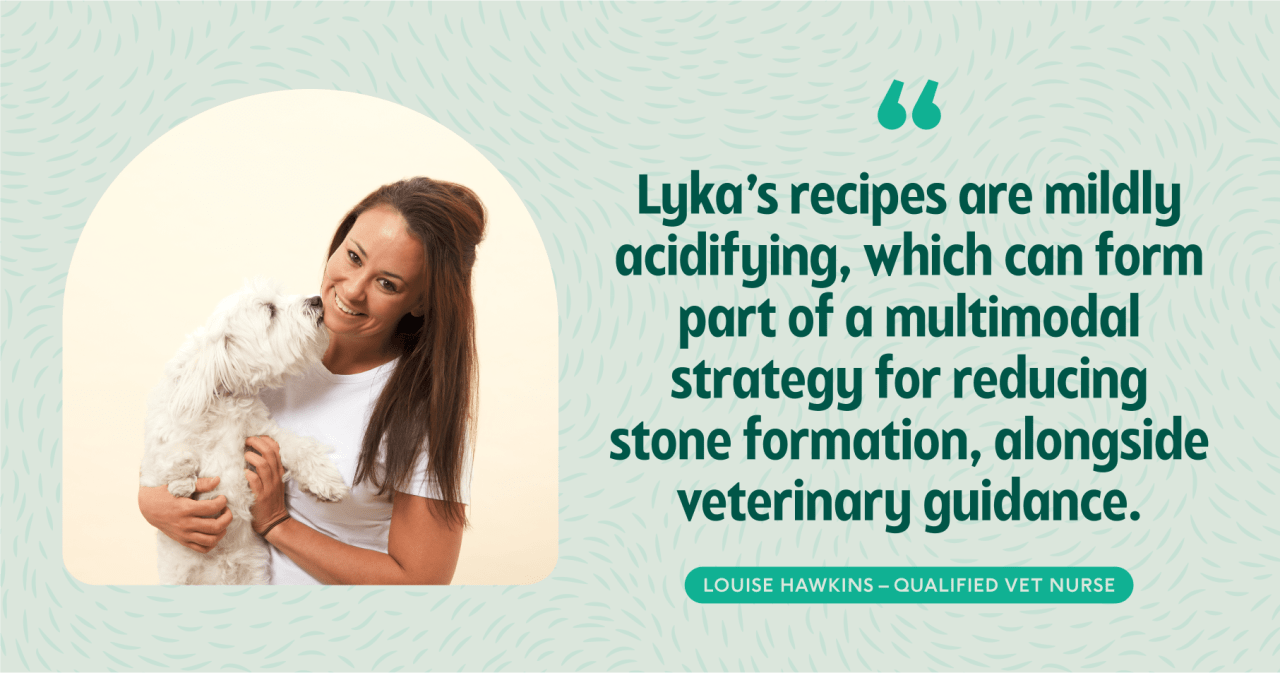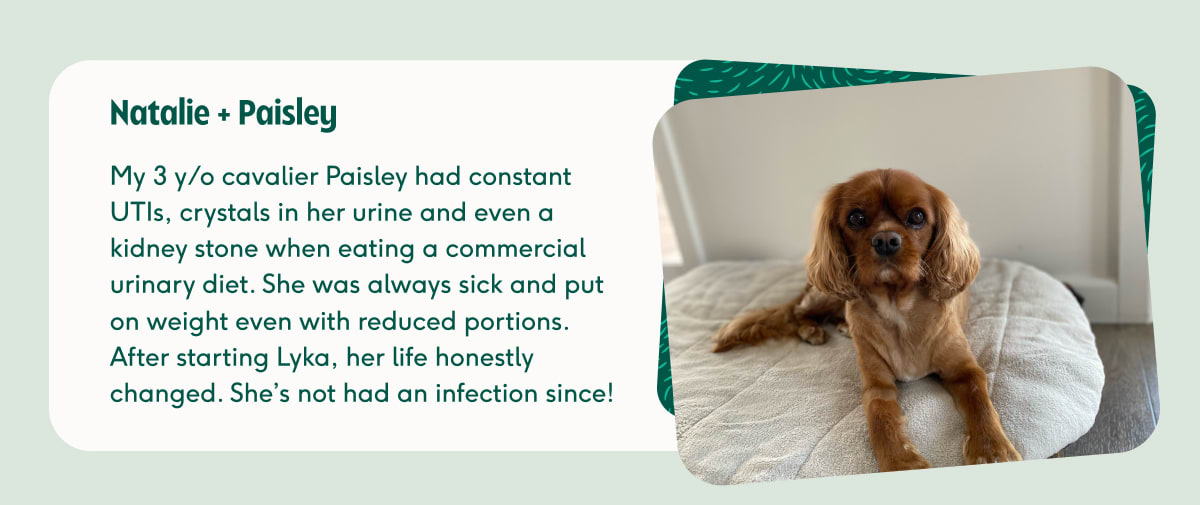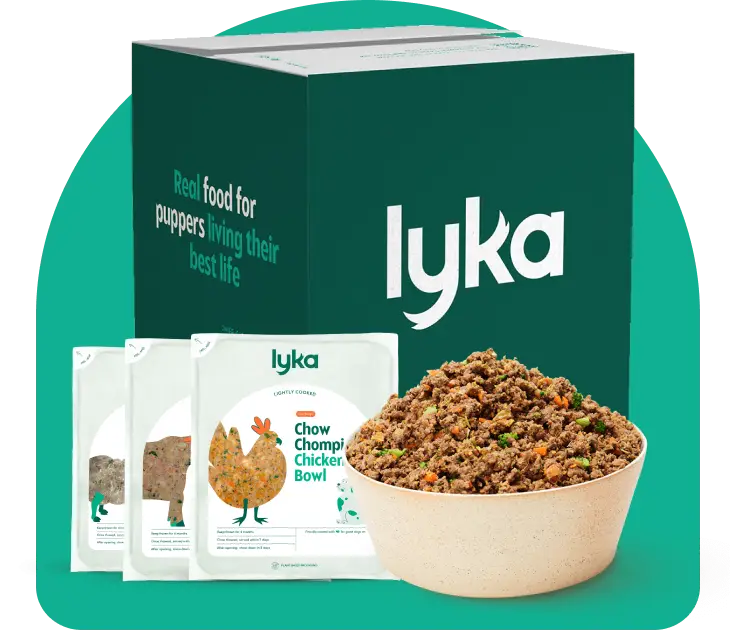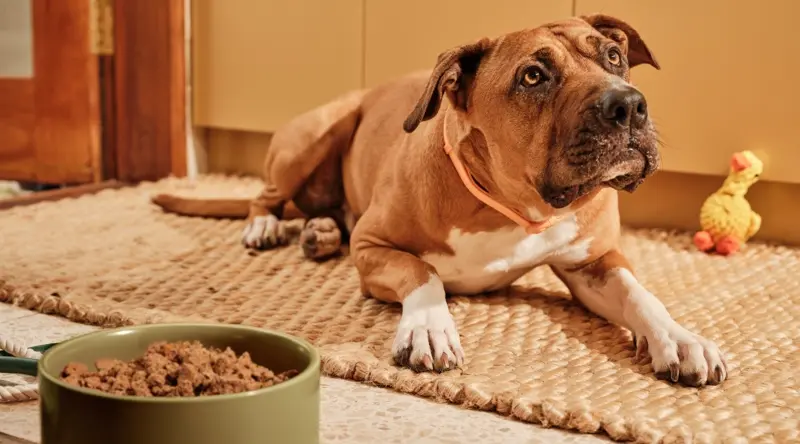Incontinence doesn’t mean your pup has suddenly forgotten their house training — it’s usually a sign of a urinary health issue.
If your dog does lose control of their bladder, they may not be aware they’ve had an accident. It’s most likely a result of illness, but it can sometimes be a behavioural issue or a sign of cognitive decline.
When it comes to your dog’s urinary health, a holistic approach can be a great option.
In this article, we explore:
Signs of a urinary health concern
Health issues that cause urinary incontinence, like urinary tract infections (UTI), age and behavioural, neurological and genetic disorders.
The best diet for an incontinent dog
Signs of a urinary health concern
If your pup is house-trained, the first indication of a urinary issue is often incontinence.
Other signs to look for:
More frequent urination than normal
Urinating in small amounts
Pain and straining when urinating
Blood in the urine
Strong smelling urine
Regular licking of their genital area
Leaking urine when lying down or unusual accidents
Burnt grass patches
Health issues related to urinary incontinence
Incontinence in dogs is usually a sign of another illness or infection, so speak to your vet if you notice any signs of urinary dysfunction.
Urinary tract infections (UTIs)
The bladder is a sterile environment. When bacteria travels up the urethra into the bladder they can multiply and cause an infection. A UTI is the most common cause of incontinence in dogs.
Treatment: Your vet will probably conduct a urinalysis of a fresh sample and may prescribe antibiotics to treat the infection. Make sure to complete the whole course of antibiotics, even if the signs of infection disappear. This ensures all of the related bacteria are killed or prevented from growing.
Preventive care to avoid UTIs includes regular grooming and bathing to keep the area clean and hygienic, frequent toilet trips and access to fresh clean water.
Urine crystals and bladder stones
Urine crystals are microscopic mineral deposits that can be formed in the urinary tract. They’re either caused by a bacterial infection, an overabundance of minerals in the urine, or a change in the urine pH level. Bladder inflammation can affect how often your dog urinates and it can lead to a build-up of crystals in their system too.
If left untreated, the crystal formations can grow into bladder stones. Small stones can be passed naturally, albeit painfully, but other stones may need to be removed in surgery. Stones can cause urinary tract blockages, which can be life-threatening, so it’s vital to treat this issue quickly.
There are four different types of crystals, each caused by different imbalances within the urine. Diet, infection, hydration and genetics can all play a part in the development of urine crystals and bladder stones.

Struvite crystals
These are most commonly formed following a bacterial infection that creates urease. Urease breaks down urea into two compounds: one that creates crystals and another that affects the pH of the urine, preventing the crystals from dissolving.
These crystals can also be formed if your dog’s normally acidic urine becomes pH neutral or alkaline.
Female dogs are more likely to develop struvite stones than males and they can be more prevalent in English Cocker Spaniels, even without a bacterial infection.
Treatment: By treating the UTI with antibiotics, you can address the infection directly. A diet with limited magnesium, phosphorus and protein is also usually recommended, as it restores the balance of minerals and pH level in the urine to enable the crystals to dissolve naturally.
Calcium oxalate crystals
Concentrated, acidic urine that has high levels of calcium, citrates or oxalates can contribute to the formation of this type of crystal. Some studies have shown a link between a diet that’s high in salt, calcium and protein, and the development of crystals and stones.
Male dogs are more likely to develop calcium oxalate stones than females.
Treatment: Increase your dog’s water intake and provide a diet that’s high in moisture to dilute their urine. Avoiding processed, dry food containing high levels of sodium is also recommended. Your vet may suggest reducing the amount of protein in their diet too.
Cystine crystals
Cystine is an amino acid that’s used in the process of tissue growth, maintenance and repair. Cystine urine crystals are a rare condition caused by a genetic mutation in Labrador Retrievers and Newfoundlands.
Treatment: As this is a genetic disorder, treatment tends to focus on preventing stone formation by increasing the dog’s water intake and providing a diet that contains limited protein and sodium.
Urate crystals
Uric acid is a waste product of metabolised purines, a chemical compound found in certain foods. If there are excessive amounts of uric acid in the urine it can cause urate crystals.
Some breeds are more prone to developing urate crystals including English Bulldogs and Dalmations.
Treatment: Like cystine crystals, the aim of treatment is to prevent the formation of urate stones. A diet that is low in purine and protein is often recommended together with improved hydration.
Behavioural urination
Even when dogs are house-trained, stress or fear can trigger the release of hormones like adrenaline that can affect their bladder control.
If your pup is anxious when they meet another dog, they may leave a little puddle. This is submissive urination — an attempt to show they’re not a threat.
Other pups may have little accidents when they’re excited about meeting a dog or human they love. This is excitement urination and fairly common in puppies, but they usually grow out of it.
Incontinence in desexed dogs
Hormone-related urinary incontinence can occur after the desexing of both female and male dogs.
Oestrogen and Testosterone hormones trigger the urethral sphincter muscle to contract for strong bladder control. When the glands producing these hormones have been removed after spaying or neutering, it can impact the effectiveness of the muscle, causing mild incontinence.
When your dog rests, their muscles relax, including the muscle that controls urination. A common sign is a small puddle or damp patch of urine that has leaked from their bladder. Your dog probably isn’t aware of it happening and may be as surprised as you are about their accident.
This type of incontinence is more likely to affect female dogs than males, especially if the female is desexed before they are six months old, but it can be something that develops at a later stage too.
For both male and female dogs, hormone-related urinary incontinence can be treated easily with medication.
Neurological disorders
Nerve damage, injury or disorders that affect the brain or spinal cord can cause urinary incontinence.
Intervertebral Disc Disease (IVDD) is a result of a herniated disc in a dog’s spine, which can affect bladder control as well as mobility. Surgery can correct IVDD, depending on the stage of the disease.
Dachshunds, Basset Hounds and Corgis can be more prone to IVDD than other breeds because of their long bodies.
Genetic disorders
Some dogs may inherit a congenital weakness in the urinary sphincter which affects its efficiency. This is more common in certain breeds like Boxers, Doberman Pinschers and Labrador Retrievers.
A rare anatomical defect that’s present at birth is an ectopic ureter. This is a condition where the tubes that normally connect the kidneys to the bladder, bypass the bladder completely, causing urine to leak. It usually affects female puppies under the age of one and can only be rectified with surgery.
Age-related incontinence
As dogs reach their golden years they can lose muscle tone and strength, including the muscles that control urination — a common cause of incontinence in old dogs.
If you notice your senior dog is leaking urine, make an appointment with your vet who can check for any underlying health issues that may be triggering the incontinence.
What’s the best diet for an incontinent dog?
Inflammation caused by diets like dry dog food has been linked to inflammatory disorders, including cystitis (bladder infection). Some kibble brands contain high glycemic index ingredients, like wheat and corn, that can trigger inflammation.
Treating your dog’s urinary concerns may require a high-moisture diet to increase their hydration. When choosing dog food, look for lean proteins and ingredients like blueberries, broccoli and turmeric that are rich in anti-inflammatory properties to support their urinary health. Spinach, kale and coconut are full of vitamins, minerals and phytonutrients that support your pup’s immune system and help to fight bad bacteria. Try to exclude anything acidic, like citrus, to prevent a pH imbalance in their bladder.
Prescription diets for urinary stones may be effective, but they can be very high in carbohydrates which can increase the risk of other issues including diabetes and obesity. Limiting the amount of protein and sodium in your pup’s diet may also help to address a urine pH imbalance contributing to urinary crystals or bladder stones.
When it comes to incontinence and urinary concerns, discuss any diet change with your vet, especially if they have a history of bladder stones.

Lyka: high-moisture, anti-inflammatory food for urinary health
Lyka’s gently cooked dog food retains the moisture and nutrients in our fresh ingredients — an easy way to encourage maximum hydration in your pup.
Our recipes also contain low-GI ingredients, low sodium levels and natural anti-inflammatory agents to minimise urinary health issues.
Our knowledgeable Customer Care team is also available to answer any questions you have about how Lyka can help your pup’s urinary issues, along with pH and acidity monitoring questions to bring up with your trusted vet.
Are you ready to join the fresh food movement?
)
)

)
)
)
)
